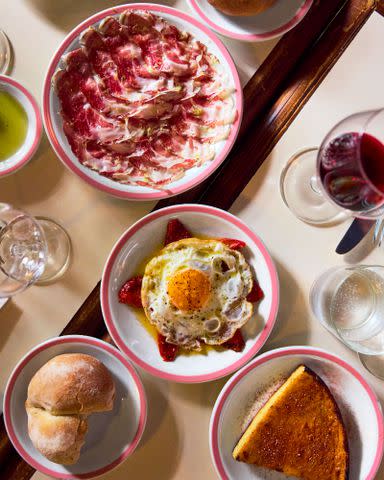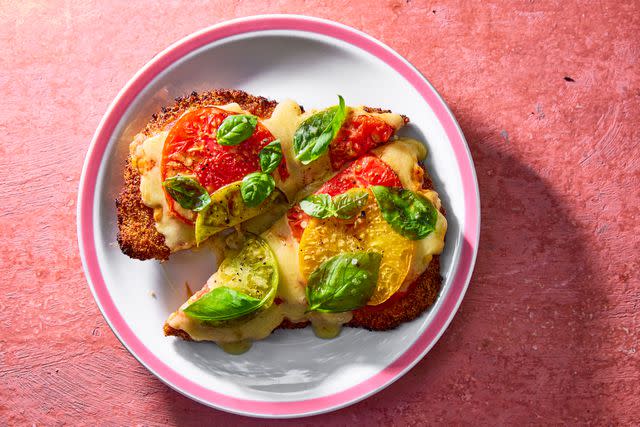How Buenos Aires’ Most Iconic Tavern Became the Hottest Table in the City
Behind the remaking of El Preferido, one of Argentina's most storied restaurants.

William Hereford
El Preferido.In years gone by, every neighborhood in Buenos Aires had a well-loved place where the locals could stop by for a drink, dine on something homey, and stick around for a few hands of penny-ante poker. Writer Jorge Luis Borges immortalized one such street-corner hangout in “The Mythical Founding of Buenos Aires,” a poem that evokes his childhood in the leafy, low-rise, working-class district of Palermo:
a general store pink
as the back of a playing card shone bright;
in the back the talk was of winning poker hands.
The corner bar flowered into life ...
The carnation-colored building of Borges’ youth was El Preferido de Palermo, a general store that also housed a type of tavern known as a bodegón. Catering to a clientele with immigrant roots in Spain and Italy, bodegones served as the standbys of Buenos Aires home cooking, or cocina porteña. Ask any old-timer about bodegón food, and they will universally describe it as “abundante, bueno, y barato” — abundant, good, and cheap.
Related:10 Oldest Pubs Around the World That Are Worth a Visit
In recent years, the winds of culinary fashion led to the decline, and often the demise, of many bodegones. El Preferido held on until 2018 before its owners closed the business. Rather than being replaced by a sushi bar or a burger joint — the fate of many bodegones — the building was purchased by Pablo Rivero, a youthful restaurateur who owns a phenomenally successful steakhouse, Don Julio, just a block away.
Rivero had always seen El Preferido as part of the blood and bones of Palermo. El Prefe, as it is affectionately known, was the archetypal symbol of the district. When the owners shuttered their business, the specter of Palermo without its beloved bodegón was, for Rivero, as unthinkable as the Bronx without Yankee Stadium. “The possibility of losing El Preferido,” he says, “was as if someone were to take a part of your body. When we bought El Preferido in the middle of a financial crisis, it was a little nuts, but I felt we had to make sure it remained. We had to make a commitment.”
Related:The Best Classic Restaurants in Every State
Rivero took over ownership of the pink building and set about resurrecting El Preferido. He was joined by his partner, the executive chef from Don Julio, Guido Tassi. Before Don Julio, Tassi had attracted a following for his gastro-bistro fare at Restó, the restaurant-in-residence at the headquarters of the Sociedad Central de Arquitectos.

William Hereford
El Preferido owner Pablo Rivero (left), and chef Guido Tassi (right).Under Tassi and Rivero, along with chef de cuisine Martin Lukesch, the new iteration of El Preferido combines the culinary techniques of modern restaurant kitchens with down-to-earth recipes and an ambitious in-house charcuterie program; flavors are fuller, textures more pronounced. It’s a formula that delivers creatively revived bodegón dishes for customers who want a taste of the past that measures up to grandma’s halcyon recipes. This is no small triumph in a contest where nostalgia comes to bat with a powerful emotional advantage.

William Hereford
On the windowsills of El Preferido, a display of ripe vegetables catches the eye.The first thing one notices when approaching El Preferido is a line of hopeful walk-ins. To pass the time while they wait, they are offered a complimentary gin and tonic. Then, you notice large square windows on both exposures to the street. Their proportions and retro hand-painted letters are reminiscent of the album cover for Linda Ronstadt’s Canciones de Mi Padre. The entranceway is an ochava, a term that describes the snubbed-off corner of a building that sits on an intersection. It’s an antique style typical of many Latin cities that creates an inviting entrance. White Formica tables range along the walls of the dining room and provide an artful background for a daily torrent of Instagram posts from enthusiastic customers. The bar lends an intimate proximity to the open kitchen, with its wood-fire station and a climate-controlled glass case — that’s where Tassi matures salami, chorizo, and a variety of sausages. There’s even pony prosciutto, a nod to Argentina’s enduring equestrian heritage.

William Hereford
Various plates from El Preferido.The menu features Milanesas of sirloin steak in a crackling crust topped with a generous slice of melted mozzarella and tomato at its summery peak. The chupín, from the same root as the Italian seafood stew cioppino, features halibut cooked en casserole with tomatoes and garbanzos. To mop up the broth, there are dinner rolls fortified with the pleasantly pungent fat trimmings of Don Julio’s butcher shop around the corner. All of the vegetables served at El Preferido and Don Julio are harvested from the restaurants’ organic garden, an hour outside of town in the fertile topsoil of La Plata. Rivero and Tassi describe their produce as seed-to-table, always of heirloom varieties cultivated for flavor rather than shelf life and shippability. For dessert, Tassi extols El Prefe’s artisanal ice creams, among them, his signature zabaione flavor laced with Marsala wine.
El Preferido’s wine list owes much to the years Rivero has spent assembling the largest collection of Argentinean wine in the country — more than 60,000 bottles. At El Prefe, he has curated a list that is less extensive — and less expensive — than Don Julio’s. According to Sebastian Ríos, the highly respected wine columnist at La Nacion, “El Preferido is a shortcut to the present and the future of Argentinean wine.” Rios also said, “The major themes on the list are drinkability and affordability. I think there’s no other Buenos Aires restaurant with such a solid by-the-glass offer.”
(Editor’s note: Another theme is that the list champions small producers with limited distribution — to sample them, you’ll need to get to Buenos Aires. See our Buenos Aires Travel Guide below for where else to drink in the city.)

William Hereford
El Preferido owner Pablo Rivero has spent years collecting Argentinean wine; his collection exceeds 60,000 bottles.For me, the perfect time to have an El Prefe meal is late lunch, when the place has cleared out a bit and I can linger over the newspaper in the light-drenched dining room. Heady drafts of meat and vegetables on the smoker drift in and out of range. My resolution to have just one glass of wine at lunch surrenders, quite reasonably, to another one to settle the soul. If the weather is fine, a café table on the sidewalk serves just as well. When it’s finally time to go and a siesta awaits, I saunter along the sleepy sun-dappled street with, perhaps, a hint of the swagger that comes naturally to folks who grew up dancing the tango.
Buenos Aires Travel Guide
Eats
Parrilla Don Julio
Located a block away from El Preferido, this is the city’s most famous steakhouse. Try the entraña, or skirt steak, and pair it with a local wine. The list, composed of Argentinean wine, includes bottles all the way back to 1923.
La Alacena
This café serves everything from baked goods to sardines from Mar del Plata. The chefs and owners, Julieta Oriolo and Mariana Bauzá, are wonderfully hospitable, and the dining room is flooded with light.
Cafe Mishiguene
The casual sibling of Tomás Kalika’s fine-dining restaurant Mishiguene, this café is part New York Jewish deli and part Jerusalem falafel stand with next-level varenikes and shakshuka.
Picsa
The latest from Leo Azulay, an alumnus of Francis Mallmann, serves Argentinean-style, semi-deep-dish pizza, using long-fermented sourdough. Eclectic sides and appetizers round out the meal.
Drinks
El Preferido owner and award-winning sommelier Pablo Rivero knows a thing or two about wine. He has curated expansive, exciting wine lists at both El Preferido and Don Julio. When he isn’t drinking at one of his restaurants, Rivero heads to these three spots for the best of Argentinean wine.
Vinoteca Lo de Joaquin Alberdi
This wine shop in Palermo offers a large selection of Argentinean winemakers. Every afternoon, it hosts tastings where you can sample new bottles along with artisan cheeses.
Ozono Drinks
In La Rioja, this superb wine shop displays its bottles in a library-like setting. Frequent tastings enable the shop to educate customers on Argentinean producers and terroir.
Bebé Vino
Located in the charming and historic Recoleta district, this wine bar that doubles as a wine shop is worth seeking out. Grab a bottle, then explore the surrounding area, an artisan-focused shopping destination called Galería Patio del Liceo.
Stay
Magnolia Hotel Boutique
This charming building is a 10-minute walk from El Preferido. The rooms are large, the breakfast is great, and the staff treats you like you’ve been coming there for years, even if it’s your first visit. (Rooms from $140)
Four Seasons Hotel Buenos Aires
A historic Belle Époque mansion makes up the two sides of this glamorous hotel (the other is an ultra-modern tower); suites in La Mansión include a private bar stocked with Argentinean wines. (Rooms from $605)
Recipes
Chupín de Pescado (Whitefish Stew with Potatoes)

Victor Protasio / Food Styling by Margaret Monroe Dickey / Prop Styling by Christine Keely
Briny olives and capers come together in this tomato-based stew with flaky grouper and smoky roasted red bell pepper. Tender potatoes and creamy chickpeas soak up the flavorful sauce for a comforting spring-time stew.
Milanesa Napolitana

William Hereford
Thinly sliced and pounded steaks are breaded and pan-fried until golden and crisp. Tomato sauce, melted mozzarella cheese, and paper-thin slices of fresh tomato are the finishing touches that give the dish its simple but distinct flair. Chill the breaded steaks before frying for a crispy crust that won’t fall off in the oil.
Fainá with Provolone Cheese

William Hereford
This twice-baked cheesy chickpea pancake picks up a lightly crisp top as the triangular pieces take a quick pass under the broiler. Nutty chickpea flour pairs well with the mild flavor and gooey melted texture of provolone cheese. Let the batter rest at room temperature to allow the flour to fully hydrate, giving the pancake a tender and custardy mouthfeel.
Zabaione Ice Cream

William Hereford
Chefs Guido Tassi and Martin Lukesch transform the classic Italian dessert, zabaione—a delicate custard made by whipping together egg yolks, Marsala, and sugar—into a silky-smooth ice cream. Dry Marsala, a fortified wine, adds rich and creamy notes of caramel, dried figs, and dates. Pay close attention while making the custard; keep the heat low, and make sure to continually whisk to avoid over- cooking the yolks.
For more Food & Wine news, make sure to sign up for our newsletter!
Read the original article on Food & Wine.

